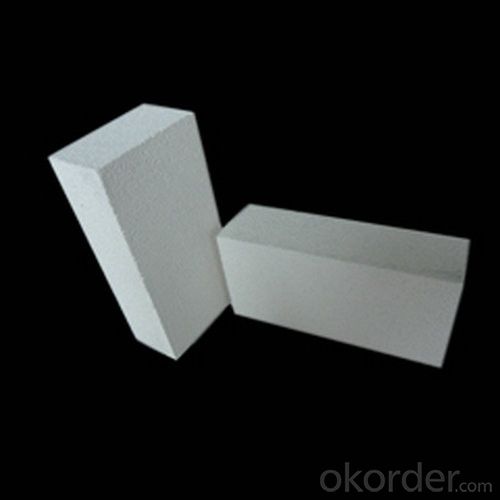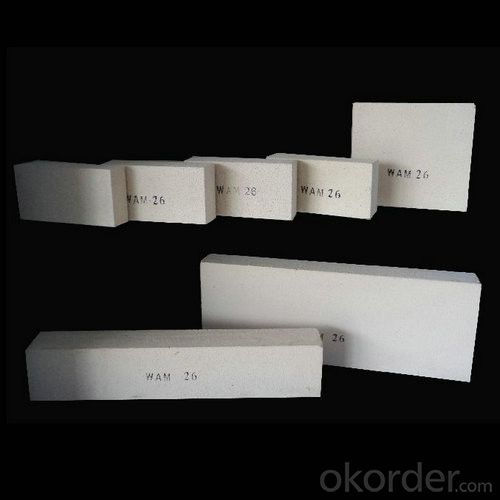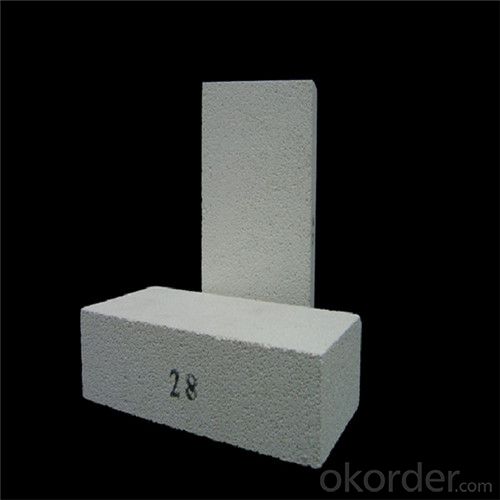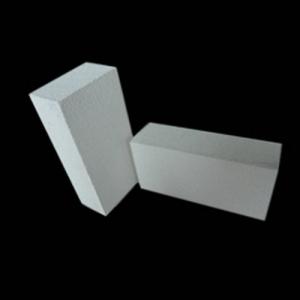INSULATION BRICK INSULATING BRICK GJM INSULATION BRICK
- Loading Port:
- Shanghai
- Payment Terms:
- TT or LC
- Min Order Qty:
- 1000 pc
- Supply Capability:
- 100000000 pc/month
OKorder Service Pledge
OKorder Financial Service
You Might Also Like
General information of Insulating Brick
Insulating firebricks are classified under tempera-ture between 1100C to 1700C, manufactured from high purity alumina clay.
Insulating fire bricks are made from high purity alumina and low iron content raw materials. The insulating fire bricks are produced by mixing, casting or extruding, drying, sintering and grinding. Our insulating fire bricks GJM23 temperature is 1260℃(2300℉). A variety of type could be done according to customer’s request.
To make our firebricks more energy and cost effective, we have different manufacturing methods for our insulating fire bricks casting and extruding method.
For insulating fire bricks GJM23,we choose the casting methord.The casting insulating fire bricks offering the lowest density, the lowest thermal conductivity for the application above 1000℃.
Application of Insulation brick
Insulating firebricks can be used as a hot face lining directly exposed to the heat or as a backup insulation layerin iron and steel mills, non-ferrous foundries, petrochemical, ceramic, glass.
Features of Insulation brick
◆Light weight and low thermal conductivity
◆Low heat storage
◆Low iron and impurities
◆High thermal shock resistance
Technical Data of GJM series Insulation brick
| JM23 | JM26 | JM28 | JM30 | JM32 | ||||
| Physical Properties: | ||||||||
| Classifiction Temperature | ℃ | 1260.0 | 1430.0 | 1500.0 | 1600.0 | 1650 | ||
| Density | Kg/m3 | 550.0 | 850.0 | 900.0 | 1000.0 | 1100 | ||
| Cold Crushing Strength | Mpa | 1.2 | 2.0 | 2.5 | 2.8 | 3.5 | ||
| Reheating Linear Change(24hrs) | ||||||||
| 1230℃ | % | 0.4 | ||||||
| 1300℃ | ||||||||
| 1400℃ | % | 0.5 | ||||||
| 1510℃ | % | 0.6 | ||||||
| 1600℃ | % | 0.7 | ||||||
| 1650℃ | % | 0.8 | ||||||
| Hot Load Strength Deform(90 minutes) | ||||||||
| 1100℃ at 0.034 Mpa(5psi) | % | 0.1 | ||||||
| 1260℃ at 0.069 Mpa(10psi) | % | 0.2 | ||||||
| 1320℃ at 0.069 Mpa(10psi) | % | 0.3 | ||||||
| 1370℃ at 0.069 Mpa(10psi) | % | 0.2 | 0.1 | |||||
| Thermal Conductivity | ||||||||
| 400℃ | W/m.k | 0.2 | 0.3 | 0.3 | 0.3 | 0.32 | ||
| 600℃ | W/m.k | 0.2 | 0.3 | 0.3 | 0.3 | 0.35 | ||
| 800℃ | W/m.k | 0.2 | 0.3 | 0.4 | 0.4 | 0.38 | ||
| 1000℃ | W/m.k | 0.2 | 0.3 | 0.4 | 0.4 | 0.42 | ||
| 1200℃ | W/m.k | 0.4 | 0.4 | 0.4 | 0.44 | |||
| 1400℃ | W/m.k | |||||||
| Specific Heat | KJ/Kg.K | 1.1 | 1.1 | 1.1 | 1.1 | 1.10 | ||
| Chemical Analysis: | ||||||||
| Al2O3 | % | 47.0 | 50.0 | 60.0 | 70.0 | 75.0 | ||
| SiO2 | % | 44.4 | 47.1 | 38.2 | 28.3 | 23.2 | ||
| Fe2O3 | % | 0.9 | 0.7 | 0.6 | 0.5 | 0.5 | ||
| TiO2 | % | 1.2 | 0.1 | 0.1 | 0.1 | 0.1 | ||
| CaO | % | 5.2 | 0.1 | 0.1 | 0.1 | 0.1 | ||
| MgO | % | 0.3 | 0.2 | 0.1 | 0.1 | 0.1 | ||
| Na2O+K2O | % | 1.1 | 1.7 | 0.8 | 0.7 | 0.6 | ||
Technical Data of B series Insulation Brick
| B-1 | B-2 | B-3 | B-4 | B-5 | B-6 | B-7 | ||||
| Physical Properties: | ||||||||||
| Density | g/cm3 | 0.7 | 0.7 | 0.75 | 0.80 | 0.80 | 0.90 | 1.00 | ||
| Cold Crushing Strength | Mpa | 2.5 | 2.5 | 2.5 | 2.5 | 2.5 | 3.0 | 3.0 | ||
| Thermal Conductivity 350℃ | W/m.k | 0.17 | 0.18 | 0.20 | 0.22 | 0.23 | 0.27 | 0.31 | ||
Technical Data of C series Insulation Brick
| C-1 | C-2 | C-3 | ||||
| Physical Properties: | ||||||
| Density | g/cm3 | 1.1 | 1.2 | 1.3 | ||
| Cold Crushing Strength | Mpa | 5.0 | 7.0 | 10.0 | ||
| Thermal Conductivity 350℃ | W/m.k | 0.30 | 0.38 | 0.45 | ||
Photo of Insulation Brick






- Q:What is the compressive strength of insulating fire bricks?
- The compressive strength of insulating fire bricks can vary depending on the specific composition and manufacturing process. However, in general, insulating fire bricks have a compressive strength ranging from 1 MPa (megapascal) to 10 MPa. This range is relatively low compared to other types of bricks due to their lightweight and porous nature, which is designed to provide excellent thermal insulation properties. It is important to note that the compressive strength of insulating fire bricks may not be as crucial as in structural bricks, as their main function is to provide insulation rather than structural support.
- Q:What is the typical creep resistance of an insulating fire brick?
- The typical creep resistance of an insulating fire brick can vary depending on the specific composition and manufacturing process of the brick. However, in general, insulating fire bricks have good creep resistance properties due to their high temperature stability and low thermal conductivity. These bricks are designed to withstand high temperatures and are often used in applications where thermal insulation and resistance to thermal stress are important, such as in kilns, furnaces, and other high-temperature industrial processes. Insulating fire bricks are typically made from lightweight refractory materials, such as alumina, silica, or other refractory oxides. These materials are chosen for their ability to resist deformation and maintain their shape under high temperatures. Creep is the gradual deformation or flow of a material under the influence of constant stress over time. In the case of insulating fire bricks, the creep resistance refers to their ability to maintain their structural integrity and dimensional stability even when exposed to prolonged high temperatures. Insulating fire bricks are designed to have low creep rates, meaning that they exhibit minimal deformation or flow under sustained stress. This is achieved through careful selection of raw materials, controlled manufacturing processes, and the addition of certain additives or binders that enhance the creep resistance of the brick. While the specific creep resistance values may vary, insulating fire bricks are generally engineered to withstand high temperatures and exhibit good resistance to creep, ensuring long-lasting performance and durability in high-temperature environments.
- Q:Can insulating fire bricks be used in steam boilers?
- Indeed, steam boilers can utilize insulating fire bricks. The purpose of insulating fire bricks is to possess minimal thermal conductivity, enabling them to efficiently retain and impede the transmission of heat from one side to the other. This renders them suitable for implementation in steam boilers, as they aid in enhancing energy efficiency by diminishing heat loss. Moreover, insulating fire bricks exhibit resistance to elevated temperatures, rendering them fitting for deployment in the steam boiler's high-temperature surroundings.
- Q:Are insulating fire bricks suitable for use in residential fireplaces?
- Insulating fire bricks can be suitable for use in residential fireplaces, depending on the specific requirements and preferences of the homeowner. Insulating fire bricks are designed to have a low thermal conductivity, which means they can effectively retain heat and prevent it from escaping the fireplace. This can result in a more efficient and effective heating of the room, as less heat is lost through the bricks. Additionally, insulating fire bricks are lightweight and easy to handle, making them a convenient option for homeowners who may want to install or replace bricks themselves. They are also durable and resistant to high temperatures, ensuring that they can withstand the intense heat produced by the fire. However, it is important to note that insulating fire bricks may not be the best choice for everyone. Traditional fire bricks are denser and have a higher thermal mass, which means they can absorb and radiate heat for a longer period of time. This can create a more consistent and long-lasting heat output, which some homeowners may prefer. Ultimately, the decision to use insulating fire bricks in a residential fireplace should be based on the specific needs and preferences of the homeowner. Consulting with a professional fireplace installer or seeking advice from a reputable supplier can help ensure that the chosen bricks are suitable for the intended use.
- Q:Are insulating fire bricks easy to handle and install?
- Insulating fire bricks are generally easy to handle and install. They are lightweight, making them easy to transport and carry around. Additionally, their shape and size are designed to be user-friendly, allowing for easy manipulation and installation. Most insulating fire bricks come with pre-drilled holes or grooves, which further simplifies the installation process. Moreover, these bricks can be easily cut or shaped to fit specific dimensions or requirements, making them highly versatile. Overall, insulating fire bricks are considered easy to handle and install, even for individuals with limited experience or knowledge in masonry work.
- Q:Are insulating fire bricks suitable for use in cement plants?
- Insulating fire bricks are indeed suitable for utilization in cement plants. Crafted from lightweight refractory materials, these bricks are specifically designed to withstand high temperatures and thermal shock. Their low thermal conductivity allows for effective insulation against heat transfer. In cement plants, where the production process generates elevated temperatures, insulating fire bricks can be applied in various ways. For instance, they can be utilized to line the kiln, which subjects raw materials to extreme temperatures in order to produce cement clinker. By possessing insulating properties, these bricks aid in minimizing heat loss and enhancing energy efficiency within the kiln. Moreover, insulating fire bricks can be employed to line the preheater tower and other areas within the cement plant that experience high temperatures. In doing so, these bricks provide both insulation and protection against the intense heat, consequently prolonging the lifespan of the equipment and reducing maintenance costs. Furthermore, the lightweight nature of insulating fire bricks renders them easier to handle and install in comparison to traditional refractory bricks. Consequently, this can save time and labor during the construction or repair of cement plant equipment. On the whole, insulating fire bricks are a suitable option for utilization in cement plants due to their resistance to high temperatures, low thermal conductivity, and ease of installation. Their implementation can contribute to enhanced energy efficiency, equipment durability, and cost savings within cement plant operations.
- Q:Are insulating fire bricks resistant to sound transmission?
- Yes, insulating fire bricks are known to have good sound insulation properties and are resistant to sound transmission.
- Q:How do insulating fire bricks affect the overall fire rating of a structure?
- The overall fire rating of a structure is greatly influenced by the use of insulating fire bricks. These bricks are specifically designed to provide effective thermal insulation, thus reducing heat transfer and the risk of fire propagation. Incorporating insulating fire bricks into the construction of walls, ceilings, and floors significantly enhances the structural integrity of the building. The insulating properties of these bricks limit the spread of fire by reducing heat conduction through building materials. This is achieved through the presence of tiny air pockets within the bricks that act as insulating barriers. As a result, the temperature rise on the non-exposed side of the wall or floor is minimized, preventing the rapid spread of fire to other areas of the structure. In addition to their thermal insulation capabilities, insulating fire bricks are also highly resistant to high temperatures. This allows them to maintain their structural integrity even when exposed to intense heat, making them highly resistant to fire damage. Using these bricks in critical areas such as fire-rated walls, doors, and fireplaces significantly improves the overall fire rating of a structure. Furthermore, insulating fire bricks offer additional benefits such as soundproofing, energy efficiency, and durability. They reduce sound transmission, creating a quieter environment inside the structure. Their excellent insulation properties also minimize heat loss or gain, resulting in lower heating and cooling costs. Additionally, their resistance to thermal shock and chemical corrosion ensures a long-lasting and reliable fire barrier. To conclude, insulating fire bricks play a crucial role in enhancing the overall fire rating of a structure. Their exceptional thermal insulation properties and ability to withstand high temperatures contribute to preventing the rapid spread of fire and minimizing fire damage. Incorporating these bricks into the construction of walls, ceilings, and floors significantly improves the fire safety of a building, providing occupants with valuable evacuation time and minimizing property loss.
- Q:Can insulating fire bricks be used in the construction of refractory linings?
- Yes, insulating fire bricks can be used in the construction of refractory linings. Insulating fire bricks are specifically designed to have excellent thermal insulation properties, making them ideal for applications where high temperatures need to be contained. They are commonly used in the construction of furnaces, kilns, and other high-temperature environments. The insulating properties of these bricks help to reduce heat loss, improve energy efficiency, and maintain a stable temperature within the refractory lining. Additionally, insulating fire bricks are lightweight and easy to handle, making them a practical choice for refractory lining construction.
- Q:What sizes are insulating fire bricks available in?
- Insulating fire bricks are available in various sizes to cater to different needs and requirements. The sizes typically range from standard sizes like 9" x 4.5" x 2.5" to smaller sizes like 9" x 4.5" x 1". These standard sizes are commonly used in fireplaces, kilns, and furnaces. Additionally, larger sizes may be available for industrial applications that require thicker insulation. It is important to note that the availability of sizes may vary depending on the manufacturer or supplier, so it is recommended to check with them for specific size options.
1. Manufacturer Overview |
|
|---|---|
| Location | |
| Year Established | |
| Annual Output Value | |
| Main Markets | |
| Company Certifications | |
2. Manufacturer Certificates |
|
|---|---|
| a) Certification Name | |
| Range | |
| Reference | |
| Validity Period | |
3. Manufacturer Capability |
|
|---|---|
| a)Trade Capacity | |
| Nearest Port | |
| Export Percentage | |
| No.of Employees in Trade Department | |
| Language Spoken: | |
| b)Factory Information | |
| Factory Size: | |
| No. of Production Lines | |
| Contract Manufacturing | |
| Product Price Range | |
Send your message to us
INSULATION BRICK INSULATING BRICK GJM INSULATION BRICK
- Loading Port:
- Shanghai
- Payment Terms:
- TT or LC
- Min Order Qty:
- 1000 pc
- Supply Capability:
- 100000000 pc/month
OKorder Service Pledge
OKorder Financial Service
Similar products
New products
Hot products
Related keywords



























